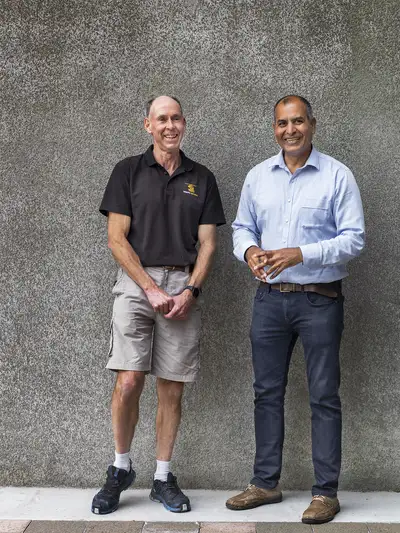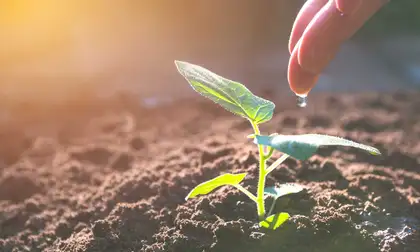Nutrients such as nitrogen and phosphorus can accumulate in the soils on farms and create leaching and runoff issues: nutrients can flow from farmland into waterways, where they promote excessive biological growth (of algae, for instance), which damages ecosystems by depleting dissolved oxygen and reducing the biodiversity of aquatic species.
Nitrate is highly soluble in water. However, nitrate is a reactive compound, so as it is moving through the environment, natural microbial activity can cause it to be denitrified back to di-nitrogen, a gaseous form which is benign in the atmosphere. This desirable process is termed nitrate attenuation. Associate Professor Ranvir Singh and Professor David Horne from Te Kura Mātauranga mō Ahuwhenua me Te Taiao School of Agriculture and Environment are researching how to increase nitrate attenuation in the flow pathways between farm systems and receiving water bodies. ‘From a sustainable development point of view we want to have a productive food system, but we don’t want nitrate to escape from farms to our receiving environment,’ says Associate Professor Singh. ‘It can leach via the drains that farmers have installed to take excess water out, and in some cases, it can go through groundwater to our waterways. In other words, nitrate can find different pathways to the receiving environment. The focus of our research is to find out where nitrate attenuation happens, why, and how we can enhance it to reduce the flow of nitrate from land to water.’
We don’t want nitrate to escape from farms

Professor David Horne and Associate Professor Ranvir Singh, Te Kura Mātauranga mō Ahuwhenua me Te Taiao School of Agriculture and Environment
Associate Professors Singh and Horne are using a combination of field observations, in-field experiments and hydrological models to study the flow of nitrate through the soil, groundwater and drainage systems to see how it gets into waterways. They have found that nitrate levels in groundwater can vary widely from one area to the next – even within the same farm – depending on variations in soil and geology.
‘We are looking to map areas of high and low attenuation in catchments,’ says Associate Professor Singh. ‘Once we can understand this, we can look at having intensive farming activities in areas that have more capacity to deal with nitrate attenuation and managing farming activities differently in areas where there is more nitrate leakage. That way we can optimise production in our catchment but have less nitrate going to our water bodies.’
Traditionally, land is classified based on its production capacity, but Associate Professor Singh believes a better approach is to incorporate into these maps the capacity of land to deal with contaminant leaching and runoff, including nitrate attenuation. ‘Imagine if we could assess and map all of New Zealand’s agricultural landscapes according to their ability to attenuate the different water contaminants, including nitrate attenuation capacities, and then align our land use activities according to that,’ he says. ‘Then we could make smarter use of the naturally existing but spatially variable nitrate attenuation capacity that exists in our catchments to reduce our nitrate loads.’ Associate Professors Singh and Horne have carried out analysis using the Tararua and Rangitīkei catchments in a preliminary modelling exercise to gauge the potential of doing this.
Another area of research involves developing smarter drainage systems for farms to help reduce nitrate leaching. It is common for subsurface drainage systems to be installed on farms in areas with fine-textured soils that hold a lot of water, or where groundwater is shallow. The drains allow these areas to be used for intensive production, but they can become pathways for nitrate to go quickly into the environment. ‘We are experimenting with a controlled drainage system, which is an open drain with a structure installed in the outlet that can be closed to hold the water back and prevent the loss of contaminants. When a storm is coming, the drain can be opened,’ says Associate Professor Singh. ‘Usually, drains always work freely, but we want them to only work in wet times.’
This controlled drainage system is applicable mostly in flat areas, however, and is challenging to manage on slopes, so Singh and Horne are working on another technology based on woodchip bioreactors. These consist of lined trenches that are filled with woodchips. They hold drainage water for a certain number of hours, depending on the flow and concentration of nitrate, and allow the same process of denitrification that happens in groundwater.
‘The chips supply the carbon; microbes grow on them and reduce the nitrate in the water,’ says Associate Professor Singh. ‘We can have quite a high level of nitrate coming in and a low level going out. This performance of bioreactors depends on the flow conditions and can be optimised for local environmental conditions. We have built a bioreactor and controlled drainage network on a farm in coastal Rangitīkei and our initial findings suggest that a combination of controlled drainage and bioreactors can decrease nitrate losses from the fields by 70 per cent. We are creating flexibility in the system and making it more user-friendly, so farmers can control and treat drainage outflow from their fields.’
Finally, Singh and Horne are also exploring the potential of systems for drainage water recycling, where farmers can identify a low-lying area, direct drainage water into a pond or dam and put it back as irrigation, supporting production and closing a nutrient loop within the farm.
‘With drainage water recycling, woodchip bioreactors, controlled drainage, or a combination of those depending on the environment we are dealing with, we can build more nutrient attenuation capacity into our landscape and make more resilient catchments that are still productive with less nitrate going into our waterways,’ says Associate Professor Singh. Associate Professor Horne agrees: ‘Traditionally, reducing leaching is often costly and constrains production. These technologies allow us to maintain productivity and mitigate the impact on the environment in a very efficient and cost-effective manner.’
Ranvir Singh and David Horne
Learn more about the researchers who are reducing nitrogen loss on farms.

Associate Professor Ranvir Singh
Ranvir is an environmental hydrologist with expertise in catchment hydrology, water quality, irrigation and agricultural drainage systems, and water productivity and footprinting sciences. His research focuses on advancing water productivity and footprinting sciences, and his knowledge of water sciences has been effective in diverse landscapes in different parts of the world.









